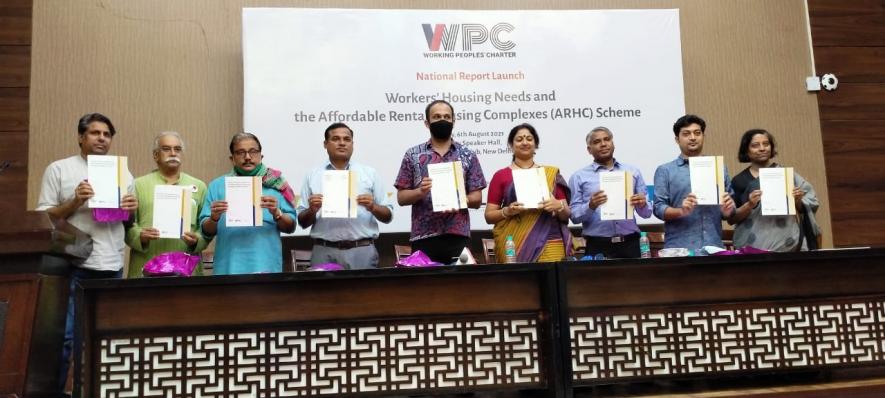Survey of Centre's Low-Cost Housing Scheme Questions Scale and Planning

Image Courtesy - Twitter
The creation of the first national-level rental housing scheme last year, under the shadow of COVID-19 pandemic, was a “positive step forward.” But will it achieve the objective of improving the living conditions of the urban poor?
This was among the pertinent questions raised on Friday, as a survey report evaluating the Affordable Rental Housing Complexes (ARHC) Scheme was launched in the presence of housing practitioners, academicians, activists, a bureaucrat and a parliamentarian.
Organised jointly by Working Peoples’ Charter (WPC), a coming together of organisations working on issues relating to informal labour, and Human Rights Law Network (HRLN) at New Delhi’s Constitution Club, the launch event also witnessed what would serve as the basis for civil society groups in order to renew the “campaign” for “decent, well-located, and low-cost housing for workers” in Indian cities.
In the month of May last year, the Narendra Modi–led Central Government announced a scheme for ARHC as part of its much-touted 'Atmanirbhar Bharat' relief package. A sub-scheme under Pradhan Mantri Awas Yojana-Urban (PMAY-U), the main aim of ARHC was to target urban migrants while giving a preference to SCs, STs, OBCs, widows and working women among others, to provide them with “accommodation at affordable rent”.
The scheme was launched ostensibly against the backdrop of the mass exodus of the migrant workers from cities, triggered by the nationwide lockdown in March earlier that year.
As such, two models of implementation of the ARHC scheme were drawn – the Union Ministry of Housing and Urban Affairs (MoHUA), which is overseeing the scheme, envisaged that it would benefit up to 2.95 lakh beneficiaries. Under the first model, existing government-funded houses that are lying “vacant” are to be converted into ARHCs by public agencies or through the Public Private Partnership (PPP) model. The another one involves construction, operation and maintenance of ARHCs by public/private entities on their vacant land.
The models, particularly the first one, however, do not seem adequate for the “calibrated demand” of informal workers and the urban poor, the survey report titled ‘Workers’ Housing Needs and the Affordable Rental Housing Complexes (ARHC) Scheme’, said. It focused on examining how housing demand would be addressed by repurposing existing vacant government-funded housing to rental units.
It further added that the housing units promised under the scheme were a “drop in the ocean.” In a written reply to the Lok Sabha last month, Minister of State in the MoHUA, Kaushal Kishore, had informed that a total of 88,236 existing vacant houses are available to be converted into ARHC. Incidentally, the Centre has also targeted the construction of 40,000 single/double bedroom houses and 1,80,000 dormitory beds under the second model.
The survey report, jointly published by the WPC, Centre for Policy Research (CPR) and India Housing Report (IHR), included findings from two different surveys – firstly, of 52 potential ARHC housing projects across 11 cities including Delhi, Mumbai, Hyderabad among others and secondly, of 19 communities, representing 9,600 households, in 7 cities – that were carried out in October and November last year.
According to the report, above all, the surveys were to analyse issues relating to the available housing projects for the scheme and the demands of urban poor with respect to rental housing.
Out of the 93,000 housing units surveyed in 52 projects, the survey found that 39% were lying vacant. However, more important were the reasons for vacancy; peripheral locations of the projects, poor construction and poor quality neighbourhoods that are “unlikely to attract renters, and consequently remain unattractive to concessionaires (public agencies or private players).”
The survey report suggested the Centre allow flexibility in rent payment, as opposed to insisting on monthly payments, considering the “unpredictable” income cycles of the urban poor. Among other suggestions included the capping of monthly rent payments under the scheme, up to a maximum limit of Rs 4,000 and “close proximity” of the ARHC projects to places of work and opportunity. The report also added that the vulnerable informal sector workers, especially migrants, were likely to “remain excluded,” not benefiting from the ARHC scheme, since it adopted a “profit-oriented model.”
“… consultations are required [with stakeholders] in order to understand project and community histories, as well as the intricacies of demand to determine the kind of housing, appropriate bundling of services, etc.,” the report said.
Mukta Naik, fellow at CPR, and one of the co-authors of the survey report, said that 22 Requests For Proposal (RFPs) have been issued by various state governments for converting the existing vacant houses into ARHCs.
“The cost of the issues [that are flagged by the report] should factor into the RFP… we do not yet know whether the state governments have considered the issues in their [issued] RFPs or not,” she said, adding that if these issues were not addressed now, problems will arise in the future.
Gautam Bhan from the Indian Institute of Human Settlements (IIHS) welcomed the survey. “An activist must never depend upon a researcher for information… [which is why] the coming together of the research and protest movement activities [through this report] is a big step for WPC and all of us,” he said.
“There is a need for all the research-oriented organisations to give a plan to the bureaucracy and the government about the mapping of the needs of people in different areas,” said Bipin Rai, member, Delhi Urban Shelter Improvement Board (DUSIB). In the absence of such mapping, he added, a scheme, particularly a housing one, can never be “fruitfully implemented”, no matter how good the intentions of a government are.
Manoj Kumar Jha, Rajya Sabha member and RJD spokesperson, pointed towards the need of “more solidarity” within the civil society members and further the growing need to “teach” the political class through such surveys.
Meanwhile, a resolution on rental housing, based on the finding of the survey report, by the WPC was also passed at Friday’s event. “The labour movement and civil society organisations must actively explore rental housing as a potential solution for bridging the gap between the provisioning of housing for workers,” it read.
Get the latest reports & analysis with people's perspective on Protests, movements & deep analytical videos, discussions of the current affairs in your Telegram app. Subscribe to NewsClick's Telegram channel & get Real-Time updates on stories, as they get published on our website.
























